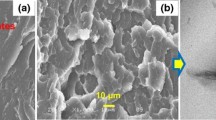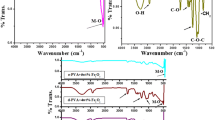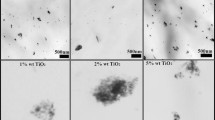Abstract
In the present study, the influence of the temperature–time mode of crystallization (TTC) on the morphology and thermal properties of PP/Fe3O4 nanocomposite materials was investigated. The morphology of the nanocomposites prepared in different TTC mode was studied by atomic force microscope. AFM study shows that the root mean square roughness of samples is 90–95, 50, 21 nm for PP/Fe3O4@20, PP/Fe3O4@200 and PP/Fe3O4@20000 respectively. Thermo gravimetric analysis was employed to investigate the thermal stability of PP/Fe3O4 nanocomposites obtained applying different TTC modes. It was found that thermal stability of water-cooled nanocomposite samples (PP/Fe3O4@200) is higher than the thermal stability of samples obtained with other two modes. Crystallization and melting behaviors of nanocomposite samples prepared in different TTC mode have been studied with DSC method and the degree of crystallinity of samples was calculated. It was found that, degree of crystalization decreases with increasing of cooling rate. The XRD patterns of samples produced in different TTC modes also correlate well with this result.
Similar content being viewed by others
Explore related subjects
Discover the latest articles, news and stories from top researchers in related subjects.Avoid common mistakes on your manuscript.
1 Introduction
In polymeric based composites, the transition from micro-sized fillers to nano-sized ones significantly changes a number of operational and technological properties associated with local chemical interactions, including: curing speed, polymer chain mobility, polymer chain deformability, structure ordering (degree of crystallization of the polymer matrix) [1]. Nanocomposites differ from conventional composite materials due to the much more developed surface area of the filler particles. The properties of such materials depend substantially on their morphology as well as the structure and properties of the interface between the matrix and the filler [2, 3].
Nanocomposite materials can be used in all aspects of information technology, such as transducer material for obtaining information, chip packaging materials and circuit boards in information processing, magnetic materials for information storage, composite fiber, sheath tube, antenna reflector panels for information transmission, and mechanical structural materials in information implementation [4]. Thermophysical properties are of great importance for determining the practical value of polymer materials and these properties depend on the crystal structure of the polymer. Regularity of the arrangement of macromolecules around filler particles plays main role for formation of different structures of polymer. Depending on the conditions of crystallization, concentration, chemical structure and molecular weight of the polymer, the molecules can fold in different crystallographic directions. As a result of such treatment, deep structural transformations take place in them, which significantly affect the properties of the resulting materials. The orientation of macromolecules also has a significant effect on the thermal properties of thermoplastics. Thermal methods for the analysis of polymer composites are in the list of the most effective methods for studying phase and other physicochemical transformations occurring between individual compounds under the influence of heat [5].
In the present work, we studied the influence of the temperature–time mode of crystallization (TTC) on the structures and thermal properties of polymer based PP + Fe3O4 nanocomposites.
2 Experimental Part
2.1 Materials
Isotactic polypropylene (PP-MoplenHF500N, Homopolymer) with the density of 0.92 g/cm3 at 25 °C was used in this study [Mw = 250,000, Mn = 67,000, Melt Mass-Flow Rate (MFR) = 11.5 g/10 min (230 °C, 2.16 kg), melting T = 162 °C].
Magnetite nanoparticles were obtained by co-precipitation in an alkaline medium. The average nanoparticle size is 7–15 nm [6].
2.2 Composite Fabrication
Composites were prepared by mixing in solution and hot pressing. Polypropylene was dissolved in toluene by stirring the mixture for about 30 min on magnetic stirrer at the temperature of 120 °C [6, 7]. The filler was added into the solution of polymer and was mixed during 2 h until the homogeneous system was obtained. Then solvent was evaporated and in the final step nanocomposites films were prepared by hot pressing method [8]. The processing temperature and time were160 °C and 5 min correspondingly while consolidation pressure was 10 MPa in the heat press. The molds were then cooled at three modes: cooling in liquid nitrogen (cooling rate 20,000 °C/min)-(PP/Fe3O4@2000); cooling in water (cooling rate 200 °C/min)-(PP/Fe3O4@200) and the slow cooling under press for 24 h (cooling rate 20 °C/min)-(PP/Fe3O4@20).
2.3 Research Methods of Polymer Nanocomposites
2.3.1 AFM Analysis
The morphology of the nanocomposites was studied using atomic force microscopу Integra Prima (NT-MDT, Zelenograd). For the scan special silicon cantilevers fabricated by plasma etching method with the needle with the radius of curvature of 20 nm and the resonance frequency of 1–5 Hz were used. Scansize was 2 × 2 mm. The measurements were performed in the semicontact microscopy mode in air and needle change of the cantilever oscillation amplitude was fixed, determining the surface topography. The scanning speed and the number of scanned lines of the image were 256 and 1969 Hz respectively.
2.3.2 XRD
X-ray diffraction analysis was performed on Rigaku Mini Flex 600 XRD diffractometer at ambient temperature. In all the cases, Cu Kα radiation from a Cu X-ray tube (run at 15 mA and 30 kV) was used. The samples were scanned in the range of angles 2θ of 20°–70°.
2.3.3 IR Study
IR study IR spectra of the samples were recorded on a spectrometer FT-IR Varian-3600 Excalibur Series, allowing to record the spectra in the range of 4000–400 cm−1.
2.3.4 Thermogravimetric Analysis (TGA)
Thermogravimetric analysis of samples was conducted in a thermogravimetric analyzer (TGA) Model Seiko Exstar 6000 TG/DTA 6300. Nanocomposites samples were heated from 30 to 650 °C with a heating rate of 100 °C/min in a nitrogen atmosphere.
2.3.5 Differential Scanning Calorimetric Analysis (DSC)
Differential scanning calorimetric analysis of nanocomposites was performed on nanocomposites by using DSC 6100 (Seiko Instruments Japan) model of Differential Scanning Calorimeter (DSC). Samples were placed into aluminum sample pans and experiments were carried out under nitrogen atmosphere with a purge rate of 20 ml/min. Samples were heated from 20 to 250 °C then cooled to 25 °C.
3 Results and Discussion
Figure 1 shows the AFM 2D images obtained for nanocomposites PP + Fe3O4 prepared in different temperature–time modes of crystallization. Figure 2 shows histogram of root-mean-square roughness of surface of PP + Fe3O4 nanocomposites. The root mean square roughness of samples are 90–95, 50, 21 nm for PP/Fe3O4@20, PP/Fe3O4@200 and PP/Fe3O4@20,000 respectively. It can be concluded from the AFM images that, quenching in liquid nitrogen (PP/Fe3O4@20,000) formed smaller crystallites than in the case of other two modes. During slow cooling of alloy, the polymer macromolecules find ways of creating a regular and large supramolecular structure around nanoparticles and this is consistent with literature. With the increasing of the cooling rate of alloy, the polymer macromolecules are without the possibility of to form a regular supramolecular structure and ultimately the structure elements on the surface of the nanocomposite become smaller.
Thermal behaviour of PP + Fe3O4 nanocomposites obtained through different temperature–time modes of crystallization (TTC) was investigated by two methods [9]. Figure 3 shows TGA curves of the PP + Fe3O4 nanocomposites produced in different TTC modes. As it can be seen from the figure, the decomposition of PP + Fe3O4 nanocomposites in all three mode occurs at one-stage [10, 11].The initial stage of thermal degradation of PP/Fe3O4@20,000, PP/Fe3O4@200 and PP/Fe3O4@20 samples started at 241.1, 290.1, 227.3 °C respectively. The results of TGA analysis of the samples are given in Table 1.
It was found that thermal stability of water-cooled nanocomposite samples (PP/Fe3O4@200) is higher than the thermal stability of samples obtained using other two modes. This is explained by the establishment of an optimal regular structure during the formation of the water-cooled nanocomposite samples. The semi-crystallinepolymers, depending on the cooling rate of the polymer melt, can exhibit two kinds of structures: amorphous and crystalline. During the cooling of nanocomposite in different TTC modes amorphous phase is formed around initial nucleus. Due to the high cooling rate, the polymeric macromolecule can not reach the most thermodynamically stable state during quenching in liquid nitrogen. In other words, around the structural centers, short-range order is formed. In contrast to this, at the slow-cooling mode there is enough time for formation of crystallites (PP/Fe3O4@20) and thus they have long-range-order. In this case, the structure obtained in water cooling mode can be assumed thermodynamically more favorable conditions for semicrystalline polymer around iron oxide nanoparticles which play the role of heat transfer centers.
DSC curves of PP + Fe3O4 nanocomposites obtained through different TTC modes are shown in Fig. 4.
Defining the heat of fusion, the degree of crystallinity of the PP + Fe3O4 polymer nanocomposites can be calculated with following relationship:
H is the melting heat, determined by the area of peak corresponding to the melting of the polymer, H0 is the heat released at the melting of 100% crystalline phase (for polypropylene, it is H0 = 207 mJ/mg). The results of DSC analysis of the PP + Fe3O4 nanocomposites obtained through different temperature–time modes of crystallization are given in Table 2.
According to the Table 2, the calculated degree of crystallinity is 51.69% for PP/Fe3O4@20 samples, 47.82% for PP/Fe3O4@200 samples and 44.15% for PP/Fe3O4@20,000. As already noted above, at the high cooling rate (PP/Fe3O4@20,000) forming crystallites have a short-range order, but in slow-cooling mode (PP/Fe3O4@20) they comprise long- range-order, which in turn increases percentage of crystalline phase. In this respect PP/Fe3O4@200 samples which quenched in water, occupy an intermediate position. It also can be seen from degree of crystallinity of samples (Table 3).
The XRD patterns of PP/Fe3O4 nanocomposites obtained through different temperature–time modes of crystallization are presented in Fig. 5. From the patterns of all three modes, a series of characteristic peaks (3 1 1), (4 0 0), (5 1 1), and (4 4 0), which are in well accordance with the inverse cubic spinel phase of Fe3O4 (= 35.4°, 43.12°, 56.98°, 62.74° magnetite), were observed [5]. Comparing obtained patterns, we can conclude that an increase in the rate of cooling of the molten materials leads to a decrease in the intensity and number of reflexes. So when the PP alloy is quenched in liquid nitrogen, reflections which are typically characteristic for smectic structures of PP are observed [12].
Figure 6 shows the IR spectra of PP and nanocomposites films based on PP + Fe3O4. The assignment of bands are as shown below [13, 14].
In contrast to pure PP, In the spectrum of PP + Fe3O4 based nanocomposites film produced by different temperature–time mode demonstrated two intense peaks, in 584 and 591 cm−1 bands, that are due to the stretching vibration mode associated to the metal–oxygen absorption band (Fe–O bonds in the crystalline lattice of Fe3O4) [15]. The absorption spectra of samples obtained through different temperature–time crystallization mode differ from each another only by intensity. This is explained by the fact that the samples taken from various modes differs from each other only by the supramolecular structure.
4 Conclusions
The AFM analysis of PP + Fe3O4 based nanocomposite samples produced by different TTC modes revealed that the root-mean-square roughness of the surface of samples which was cooled (PP/Fe3O4@2000) in liquid nitrogen is smaller than this of the samples obtained in the other two modes. This explains smaller size ofthe crystallites in the samples cooled in liquid nitrogen. At the same time, the results of the TGA analysis exhibited that the thermal stability of water-cooled nanocomposite samples (PP/Fe3O4@200) is higher than the thermal stability of nanocomposite samples produced in other two regimens. The results of DSC analysis of samples produced through application of various TTC modes show that, crystallinity decreases with increasing the cooling rate of alloy. The XRD patterns of samples produced in defferent TTC modes are also in accordance with this result. Analytical results show that, increase of cooling time of samples causes the ratio of crystalline phase in nanocomposite materials based on polycrystalline polymer, such as isotactice polypropylene to increase. During formation of supramolecular structure of the polymer at the different cooling rates, the structureof polymer and polymer/filler interaction cause a veriosity of the thermal conductivity and, accordingly, the thermal stability of the materials. The higher thermal stability of samples cooled in water (PP/Fe3O4@200) can be explained by this fact. IR spectra of samples produced by different temperature–time mode shows that, this nanocomposite samples differ each other only by supramolecular structure.
References
A.A. Eliseev, A.V. Lukashin, Functional Nanomaterials (Fizmatlit, Moscow, 2010)
A.M. Maharramov, M.A. Ramazanov, F.V. Hajiyeva, S.Q. Aliyeva, Formation of nanoporous structures of polypropylene irradiated by high energy heavy ions. J. Nanomed. Nanotechnol. 3, 5 (2012)
А.M. Мagerramov, М.А. Ramazanov, F.V. Hajiyeva, V.М. Guliyeva, Investigation of structure and electrophysical properties of nanocomposite materials on the basis of zirconium dioxiden in isotactic polypropylene matrix. J. Ovonic Res. 9(5), 133 (2013)
R.-M. Wang, S.-R. Zheng, Y.-P. Zheng, Polymer Matrix Composites and Technolgy (Woodhead publishing, Philadelphia, 2011)
H. Shirinova, L. Di Palma, F. Sarasini, J. Tirillò, M.A. Ramazanov, F. Hajiyeva, D. Sannino, M. Polichetti, A. Galluzzi, Synthesis and characterization of magnetic nanocomposites for environmental remediation. Chem. Eng. Trans. 47, 103–108 (2016). https://doi.org/10.3303/CET1647018
M.A. Ramazanov, F.V. Hajiyeva, A.M. Maharramov, L. di Palmab, D. Sanninoc, M. Takafuji, H.M. Mammadov, U.A. Hasanova, H.A. Shirinova, Z.A. Bayramova, New magnetic polymer nanocomposites on the basis ofisotactic polypropylene and magnetite nanoparticles for adsorption of ultra high frequency electromagnetic waves. Polym. Plast. Technol. Eng. J. (2017). https://doi.org/10.1080/03602559.2017.1320721
A.M. Maharramov, M.A. Ramazanov, R.A. Alizade, P.B. Asilbeyli, Structure and dielectric properties of nanocomposites on the bas of polyethylene with Fe3O4 nanopatricles. Digest J. Nanomater. Biostruct. 8(4), 1447 (2013)
МА Ramazanov, R.А. Ali-Zade, P.B. Agakishieva, Structure and magnetic properties of nanocomposites, on the basis PE + Fe3O4 и PVDF + Fe3O4. Digest J. Nanomater. Biostruct. 5(3), 727 (2010)
A.M. Maharramova, M.A. Ramazanov, L. Di Palma, F.V. Hajiyeva, H.А. Shirinova, U.A. Hasanova, Role of structure of the Pp/magnetite nanocomposites on their thermal properties. Chem. Eng. Trans. 60, (2017)
M.A. Ramazanov, A.S. .Huseynova, N.A. Eyubova, S.A. Abasov, Thermal properties and changes in phase structure of PP+MnO2 based composites j. Optoelectron. Adv. Mater. Rapid Commun. (OAM-RC) 4(12), 2003 (2010)
M.A. Ramazanov, A.M. Maharramov, F.V. Hajiyeva, F. Kirac, O. Guven, Morphology, mechanical and thermal properties of nanocomposites based on isotactic polypropylene and zirconium dioxide nanoparticles. Romanian J. Mater. 46(3), 375–382 (2016)
I.I. Perepechko, A. Beknazarov Introduction to Polymer Physics. Chemistry (Mir Publishers, Moscow, 1978)
D.l. Bower, W.F. Maddams, The Vibrational Spectroscopy of Polymers (Cambridge University Press, Cambridge, 1992)
H.N. Türkçü, Investigation of the crystallinity and orientation of polypropylene with respect to temperature changes using FT-IR, XRD, AND Raman techniques. (2004)
A. Bava, F. Cappellini, E. Pedretti, F. Rossi, E. Caruso, E. Vismara, M. Chiriva-Internati, G. Bernardini, R. Gornati, Heparin and carboxymethylchitosan metal nanoparticles: an evaluation of their cytotoxicity. Biomed. Res. Int. (2013). https://doi.org/10.1155/2013/314091
Author information
Authors and Affiliations
Corresponding author
Electronic supplementary material
Below is the link to the electronic supplementary material.
Rights and permissions
About this article
Cite this article
Ramazanov, M.A., Maharramov, A.M., Hajiyeva, F.V. et al. The Effect of the Temperature–Time Mode of Crystallization on the Morphology and Thermal Properties of Nanocomposites Based on Polypropylene and Magnetite (Fe3O4). J Inorg Organomet Polym 28, 1171–1177 (2018). https://doi.org/10.1007/s10904-017-0767-6
Received:
Accepted:
Published:
Issue Date:
DOI: https://doi.org/10.1007/s10904-017-0767-6










